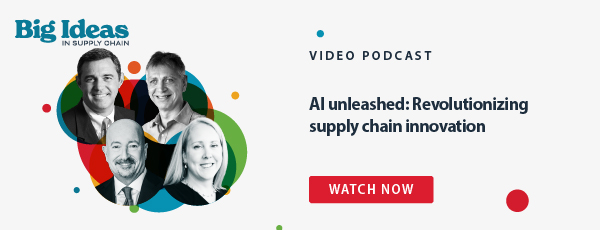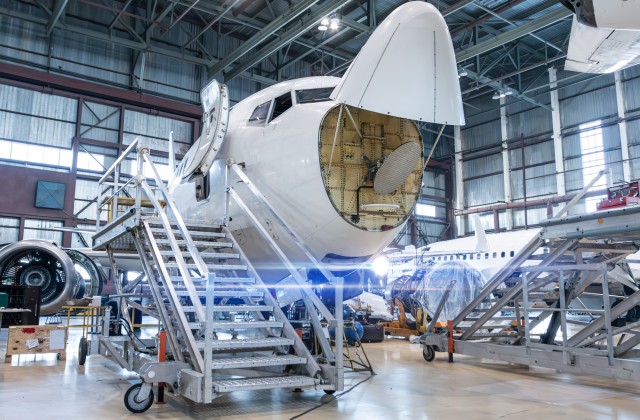Today, the topic of AI is at the forefront of every supply chain leader’s mind thanks to the rising popularity of generative AI tools like ChatGPT. As organizations begin to integrate this new technology across their company, boards are eager to know what happens next and how it will affect their supply chains moving forward. After all, as AI continues to evolve, will supply chains also evolve for the better?
The good news is new opportunities are on the horizon that can increase the pace of innovation like never before, so the future of AI is bright. For supply chain and AI experts Kevin O’Marah, Co-founder and Chief Research Officer for Zero100, and Pascal Van Hentenryck, Professor at the Georgia Institute of Technology and Director of AI4OPT, the ability to optimize machine learning through data proliferation is going to revolutionize the way practitioners solve problems, address time constraints, and plan.
In this episode of Big Ideas in Supply Chain, Kevin and Pascal are joined by Angel Mendez, Board Member and Supply Chain Innovator, and Dr. Anne Robinson, Chief Strategy Officer at Kinaxis, to deliver practical strategies for harnessing massive-scale data for accelerated supply chain innovation.
What’s next for the supply chain
For many organizations, implementing AI isn’t an entirely new concept in the supply chain. Tools like chatbots, automation, and machine learning are pieces of technology that companies have been using successfully for years – but C-Suite executives want to know what they can expect on the horizon.
Pascal recognizes we’re aiming to do things that aren’t possible yet – like tackling time constraints that we can’t currently meet or solve problems outside the scope of technology – that AI will be able to solve in the near future. He says the biggest opportunity in AI is that we can do things that could not be done before AI, and we’ll soon see a lot of improvements in planning and operations coming down the pipe. Pascal uses a commerce company as an example to explain what this might look like in the future, saying, “What we can do now is automate and really optimize their sorting facilities, for instance. […] The other thing that’s going to happen is AI-assisted X, something. I think you’re going to see AI improving how planners are going to work, helping them ask the right questions, helping them to do scenario analysis at the speed that is not even imaginable right now.”
Kevin says there are numerous opportunities in AI, because supply chain has been gated by the human factor for thirty years. “[Humans] have to go to sleep at the end of the day and we can learn from our experiences previously, whether it’s a nice high-end planning engine or some sort of robotic and automation solved in the shop floor. But that gating factor is removed when you start using the data sets that are out there today,” he says. Enhancing what humans can do and removing everyday constraints will create a lot of exciting opportunities to accelerate processes in ways that weren’t previously possible.
Mastering your data strategy
A major concern for organizations looking to adopt AI is data accuracy, which many practitioners see as a barrier. Kevin and Pascal agree that having a solid data strategy in place may make it less of an obstacle, however.
According to Kevin, the key to getting your data right is to ask precise questions to determine what issues you need solved as opposed to worrying about how clean your data is. “It’s ‘what problem am I trying to solve’ and ‘what data would be great to have’ to solve it. Start there and see if your data is good enough to take crack at it, and if it’s not all perfect, you may be okay taking a run at it and then tuning the data. Rather than cleaning every single element of the data, find the data interfering with the performance and fix that.” He suggests focusing on incrementalism by determining key pain points.
Pascal builds on Kevin’s perspective, reinforcing the importance of data. He states that while optimization and machine learning aren’t possible without data, the data that we have now compared to what we had five years ago has significantly improved. Companies are often less concerned with extracting and cleaning the data they have, which has been a game changer. Pascal also points out that you may not need all the data to start with.
“So, when we work with partners, we tell them, give us as much as you can but we’re going to augment the data because we are also good in forecasting. We’re going to build models and we’re going to generate out. What we do is something called data augmentation. We take the data and under a reasonable assumption, we can generate more data, and now we can try to model with that data,” Pascal says. “You don’t have to start with an end-to-end supply chain. You can start with different places and then, you in a sense, create a culture of data inside your company and they will see the benefits very quickly.”
Regulatory roadblocks
While the potential for supply chain innovation in AI is abundant and exciting, many industry leaders are worried about the risk of overregulation. This technology is new and untested, so regulators could potentially create barriers out of uncertainty that may prevent progress. Both of our experts agree that even with technologies in place for privacy management this is an important concern to address.
Pascal has been working on a new technique called Differential Privacy that is aimed at removing some of these regulatory barriers by reinforcing privacy. “It’s a technology that gives you as much guarantees as you can have while staying practical. So, you basically represent your data set. You have a high fidelity of your data set. At the same time, the probability of identifying someone is very low and you can control that probability,” he says. Pascal says it’s important to inform the government that this type of privacy is reasonable. With these acts in place, citizens will have high guarantees to the fidelity they want on their data.
Kevin also agrees that potential regulatory barriers could halt progress, especially if you’re trying to regulate something that isn’t enforceable. “There are principles written in some of the draft stuff in the EU that I think sound principled correctly, intended correctly, but can you enforce it? And if you can’t enforce it, then I think you end up with a regulatory framework that’s a 55 mile/hour speed limit. Everybody is speeding the entire time. So, what’s the point of paying any attention to the laws at all?”
If AI continues to stay on the fast track, our experts agree that we’re in an exciting place right now. The potential for innovation within the supply chain is ripe with possibilities that they can’t wait to explore.
To hear more about revolutionizing the supply chain through AI innovation from Kevin, Pascal, Angel, and Anne, watch the full video podcast here:
For additional perspective into AI's impact on supply chain strategies, watch our Big Ideas in Supply Chain podcast Predicting ChatGPT's impact on the future of supply chain.






